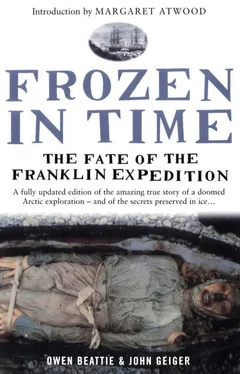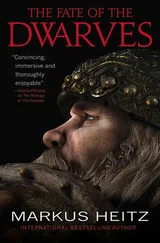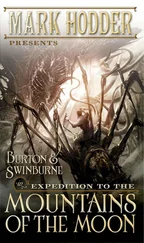The Back expedition was an enormous setback for the Admiralty. Still, there was no attempt by British authorities to examine the causes of the illness amongst Back’s crew. Even if there had been, the probable cause—the expedition’s heavy reliance on tinned foods and the absence of fresh meat—would almost certainly have eluded suspicion. Indeed, four years after Back’s return there was a push within the Royal Navy to replace all livestock on expeditions with tinned food. Wrote Captain Basil Hall:
Meat thus preserved eats nothing, nor drinks—it is not apt to die—does not tumble overboard or get its legs broken or its flesh worked off its bones by tumbling about the ship in bad weather—it takes no care in the keeping—it is always ready, may be eaten hot or cold, and this enables you to toss into a boat as many days’ cooked provisions as you require.
In 1844, Second Secretary to the Admiralty John Barrow argued for one final attempt to complete the Northwest Passage. Barrow wanted to finish what he had started a quarter-century before, fearing that England, having “opened the East and West doors, would be laughed at by all the world for having hesitated to cross the threshold.” Glossing over Back’s setback, Barrow, in his bid for funding, opted to focus instead on a gloriously successful trio of Antarctic cruises undertaken by John Ross’s nephew, James Clark Ross, from 1839–43:
There can be no objection with regard to any apprehension of the loss of ships or men. The two ships that recently were employed among the ice of the Antarctic sea after three voyages returned to England in such good order as to be ready to be made available for employment on the proposed North-West expedition; and with regard to the crews, it is remarkable that neither sickness nor death occurred in most of the voyages made into the Arctic regions, North or South.
As far as Barrow was concerned, he had the right ships, the Erebus and Terror, and he had the right commander in Ross.
James Clark Ross’s Antarctic expedition had charted some 500 miles (805 km) of the southern continent’s coastline, discovered the Antarctic ice shelf and sighted a smoking volcano, which Ross named Mount Erebus after his ship (a nearby crater was named Mount Terror after the smaller of the two vessels). When he returned to England in the autumn of 1843, Ross had earned himself the title of the world’s leading polar discoverer. The expert in ornithology and the science of terrestrial magnetism was knighted and presented with the Founder’s Medal of the Royal Geographical Society. He cut quite a dash in Victorian society, and was once said to be “the handsomest man in the Royal Navy,” no small compliment given the preening to which the officer class was prone.
The Erebus and Terror were not nearly so handsome. Royal Navy bomb vessels designed for shore bombardment, they were sturdily built to withstand the recoil of their 3-ton (3.1-tonne) mortars. But the Terror, in particular, had an interesting history. Built in 1813, a ship of that name was engaged the following year in the Battle of Baltimore, which saw British ships of war firing bombs, rockets and cannons at Fort McHenry. The 25-hour barrage failed to dislodge the Americans and gave rise to the U.S. National Anthem, the Star-Spangled Banner, with its reference to “the rockets’ red glare.” The Terror later saw service in the Mediterranean before it was sailed into Hudson Bay under the command of George Back. After its narrow escape from the Arctic, the Terror, together with the Erebus, was reinforced for protection against the ice for Ross’s Antarctic voyages.
Further reinforcements were made for the planned Northwest Passage expedition, set to embark in May 1845, including covering the ships’ bows with sheet iron. Other changes were made to assist the expedition as it made its way through Arctic waters. The ships were fitted with a tubular boiler and steam-forming apparatus, which conveyed hot water in pipes under the decks to warm the men’s berths and all other parts of the vessels. Desalinators were built into the galley stoves. In a revolutionary step, entire steam locomotives with specially adapted screw propellers were also installed, for emergency use. A 25-horsepower locomotive from the London and Greenwich Railway was bought for the Erebus, stripped of its front wheels and installed in the ship’s hold. The engine of the Terror, at 20 horsepower, was placed in the after-hold.
On 12 May 1845, the Times reported:
The Lords Commissioners of the Admiralty have, in every respect, provided most liberally for the comforts of the officers and men of an expedition which may, with the facilities of the screw-propeller, and other advantages of modern science, be attended with great results.
It was, in short, the most technologically advanced and best-equipped exploration team ever. However, it was not to be commanded by James Clark Ross, who declined due to a promise he had made his wife—to never again undertake a polar expedition—and a rumoured problem with the drink. Instead, the honour fell to an aging navy veteran, Sir John Franklin.
At fifty-nine, Sir John Franklin was widely considered too 1 old for the command. Lord Haddington, First Lord of the Admiralty, shared the doubts of many about Franklin’s fitness but agreed to interview him. During that meeting, the First Lord told Franklin of his concerns. “You are sixty,” he said. Franklin was nonplussed: “No, my lord, I am only fifty-nine.” Still, the Admiralty was nothing if not an old boys’ club, and William Edward Parry lobbied on Franklin’s behalf, telling Haddington: “If you don’t let him go, the man will die of disappointment.” On 7 February 1845, Franklin was given the job.
Born in Spilsby, Lincolnshire, on 16 April 1786, Franklin entered the Royal Navy when he was fourteen and served in a number of famous battles during the Napoleonic Wars, including the Battle of Trafalgar. In 1814, he would be injured in a disastrous attempt to capture New Orleans. When the Duke of Wellington finally defeated Bonaparte in the Battle of Waterloo in 1815, the Royal Navy was forced to look for new assignments for its best young officers. Arctic exploration was one way for such officers to distinguish themselves in peacetime. And so it was that, in May 1818, Franklin began his polar service as second-in-command of Captain David Buchan’s failed voyage into the Spitsbergen ice.
Daguerreotype of Sir John Franklin.
In 1819 Franklin again headed north, this time in command of an overland expedition ordered by the British Admiralty to travel from Hudson Bay to the polar sea, where he was to map North America’s unexplored Arctic coast. George Simpson of the Hudson’s Bay Company was highly skeptical of Franklin’s qualifications for such a journey:
Lieut. Franklin, the Officer who commands the party has not the physical powers required for the labor of moderate Voyaging in this country; he must have three meals p diem, Tea is indispensible, and with the utmost exertion he cannot walk above Eight miles in one day, so that it does not follow if those Gentlemen are unsuccessful that the difficulties are insurmountable.
Franklin succeeded in surveying 211 miles (340 km) of the icy shoreline east of the Coppermine River before a tragic return journey over the Canadian tundra, or “Barren Grounds,” during which expedition members were reduced by starvation to eating an old leather shoe and caribou excrement. Ten men died from the cold and hunger, exacerbated in part by Franklin’s unfamiliarity with northern conditions. Franklin himself nearly succumbed to starvation before relief arrived. Yet when he returned to London, Franklin’s account of heroic achievement marred by murder, cannibalism and his own suffering caught the public’s imagination, and he became known as the man who ate his boots. Promoted to the rank of captain, he then returned in 1825–27 to the Arctic for a well-organized second overland expedition, resulting in the mapping of another 397 miles (640 km) of Arctic shoreline, for which he was knighted. Finally, after a six-year stint as colonial governor of Van Diemen’s Land (today, the Australian state of Tasmania), Franklin was placed in command of the greatest single expedition of discovery Britain had ever mounted.
Читать дальше










